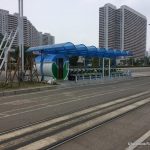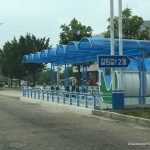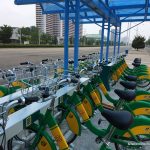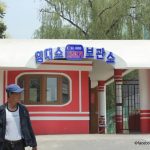UPDATE 1 (2018-3-30): A couple of recent visitors to North Korea have reached out to claim that the bike service still has yet to be put into use. I will update this post when I learn more.
ORIGINAL POST (2018-3-26):
Pictured Above (Russian Embassy): Two bike rental stations on Kwangbok Street and the Taehung Bicycle Rental and Storage Station (대흥 자전거 임대소 보관소) on Youth Street.
The Pyongyang Times (2018-3-8) has published an article on the new Pyongyang bike share program:
People riding brightly-coloured bikes along Kwangbok Street present an unusual scene in Mangyongdae District, Pyongyang.
Small yet cosy stations with blue roofs are seen in several places of the street, with lines of cute bicycles arranged and people bustling especially at rush hours.
They are part of service centres run by the Pyongyang bike-sharing company.
This year the company has started the bike rental service.
An online service management system, the bike-sharing system is expected to be one of the favoured public traffic service systems.
Customers need to buy cards to hire bikes at any of the stations.
They can pass the cards through card readers at any stations, input passwords to unlock the bikes and use them. They pay fees when they return them to any of the stations.
Bike-sharing is an environment-friendly and energy-saving service that suits the local conditions as it helps reduce urban pollution by vehicles and save fuel.
The stations generate electricity needed for service activities by utilizing solar energy.
“Bike-sharing is widely adopted by many countries as part of global efforts to reduce pollution,” said Myong Si Man, director of the company. “Our system helps not only satisfy the growing demand for traffic means but also promote public health. We plan to widen the coverage of bike-sharing service to other parts of the city and upgrade the method of service.”
Riding bike is good for health and some elders in the district share bikes just for an exercise, he added.
Stylish Ryomyong-brand bikes are helpful to ensuring clean environment of Pyongyang and providing convenience for passengers. It now adds a special touch of beauty to the city.
This is not the first mention in the North Korean media. In July of last year Tongil News reported the first bikes were brought in to the rental stations on the 1st of July 2017 and services were due to begin in late July 2017. According to this South Korean source, however, the service did not actually begin until January 15, 2018 (consistent with the claim in this PY Times article).
According to Tongil News, the bikes are called Ryomyong (려명) bikes and come from a North Korean/Chinese joint venture called Phyongjin Bicycle Cooperative Company (평진자전거합영회사) located in Sosong District (서성구역), Pyongyang. The payment cards needed to rent the bikes are called Ryomyong Cards and need to be bought with a Jonsong Card at one of the five locations on Kwangbok-street. The overall operation is overseen by the Pyongyang Bicycle Rental Office (평양자전거임대관리소).





